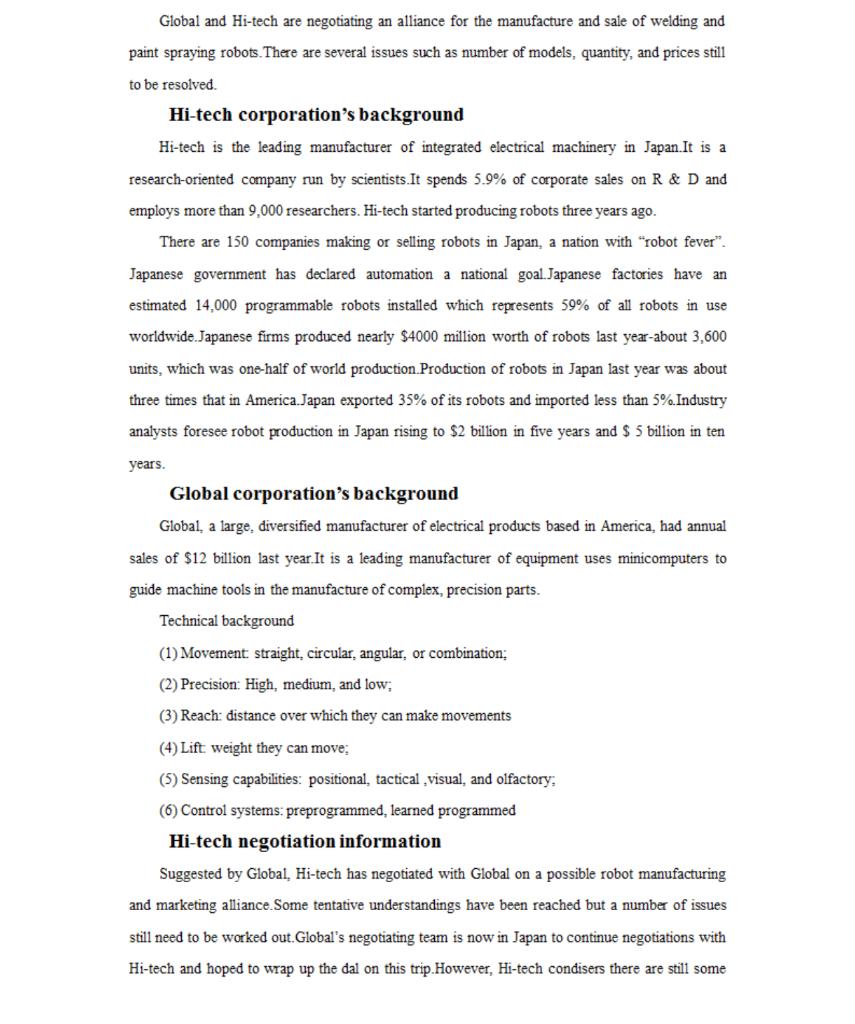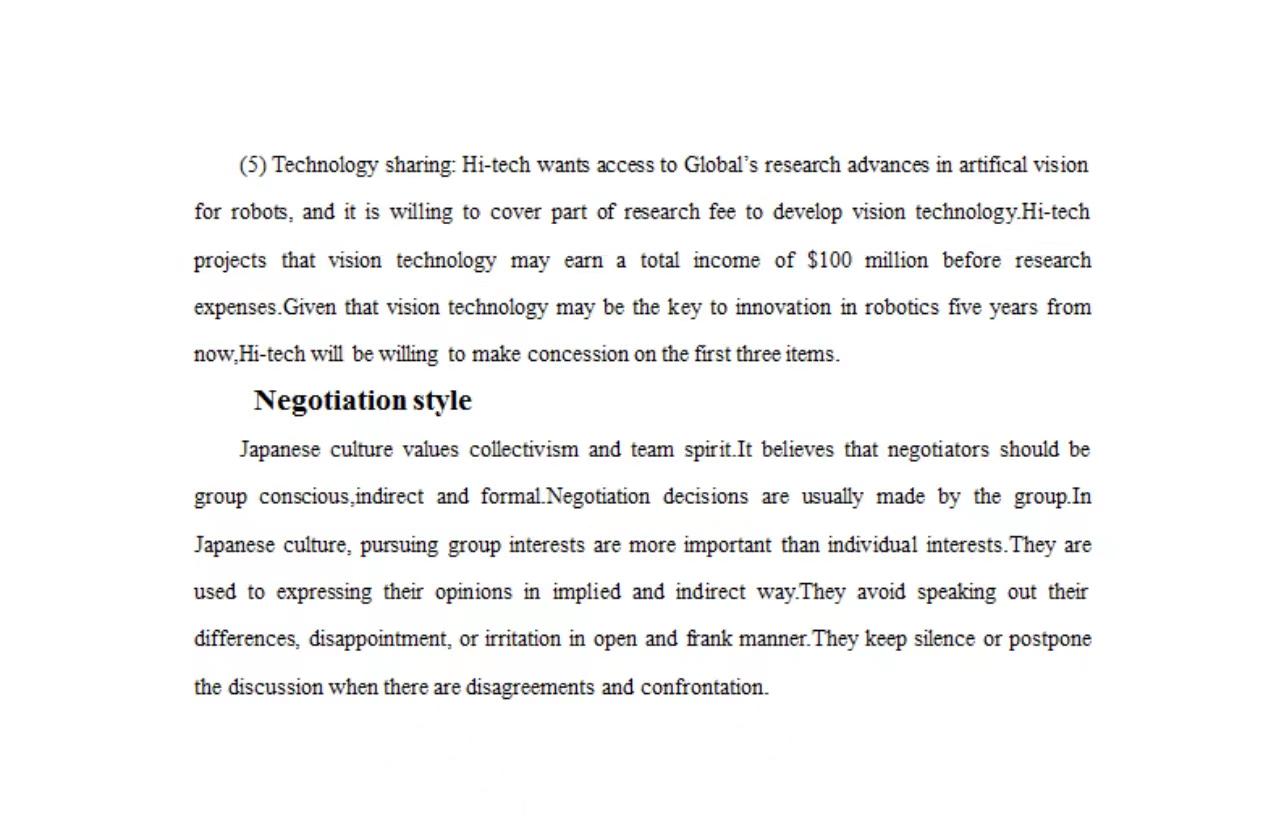



assignment: Hi-tech.Please accomplish the following task: 1. makes a plan for this coming negotiation based on Ten points(please refer to Chapter 4). 2. Based on the plan, please communicate with your partner through the wechat and save a screenshot during you are talking. Negotiation planning guide * 1.defining the negotiating goal 2.list the major issues in the negotiation related to achieving the goal. - 3.define their relative importance of each issue, and define the bargaining mix. * 4.define the interests - 5.define the alternatives(BATNAS) - 6.define your limits, including a resistance point - 7.describe your understandingg of the other party's goals, issues and resistance points - 8.set your targets and opening bid 9.assess the social context the negotiation 10.outline how you will present the issues to the other party:what to say and how to say it. Global and Hi-tech are negotiating an alliance for the manufacture and sale of welding and paint spraying robots. There are several issues such as number of models, quantity, and prices still to be resolved. Hi-tech corporation's background Hi-tech is the leading manufacturer of integrated electrical machinery in Japan.It is a research-oriented company run by scientists.It spends 5.9% of corporate sales on R&D and employs more than 9,000 researchers. Hi-tech started producing robots three years ago. There are 150 companies making or selling robots in Japan, a nation with "robot fever". Japanese government has declared automation a national goal.Japanese factories have an estimated 14,000 programmable robots installed which represents 59% of all robots in use worldwide.Japanese firms produced nearly $4000 million worth of robots last year-about 3,600 units, which was one-half of world production.Production of robots in Japan last year was about three times that in America.Japan exported 35% of its robots and imported less than 5%.Industry analysts foresee robot production in Japan rising to $2 billion in five years and $5 billion in ten years. Global corporation's background Global, a large, diversified manufacturer of electrical products based in America, had annual sales of $12 billion last year. It is a leading manufacturer of equipment uses minicomputers to guide machine tools in the manufacture of complex, precision parts. Technical background (1) Movement: straight, circular, angular, or combination; (2) Precision: High, medium, and low; (3) Reach: distance over which they can make movements (4) Lift weight they can move; (5) Sensing capabilities: positional, tactical , visual, and olfactory; (6) Control systems: preprogrammed, learned programmed Hi-tech negotiation information Suggested by Global, Hi-tech has negotiated with Global on a possible robot manufacturing and marketing alliance.Some tentative understandings have been reached but a number of issues still need to be worked out.Global's negotiating team is now in Japan to continue negotiations with Hi-tech and hoped to wrap up the dal on this trip.However, Hi-tech condisers there are still some important issues remaining unsloved, so they are not in a hurry. The projection of the robot production is rising by 5 times in 5 years and by 12.5 times in 10 years, so Hi-tech is facing more and more severe competition at the domestic market The expansion into foreign market is a way to reduce its domestic pressure. America is the most promising market for robots and at present its production can not compete Japanese frims although the country is developing some of the technology that Japanese firms are lacking. Hi-tech's long term, strategic objective is to further open American market and double its market share in five years' time and then set up a research and production base in America to develop several new models.Global is an ideal partner for it to achieve its goal, besides, Global can offer its partner many benefits. It has one of the largest industrial sales, distribution and service networks in America. It has more experience in selling factor automation packages than any other firm in the world. There is also the possibility for the two companies to ccoperate on new models. In prior negotiations the companies have tentatively agreed on the following intems: (1)The agreement will focus on spraying and welding robots that Hi-tech currently markets. (2)The agreement will run for seven years in two phases. In phase one, the first four years, Global will buy fully-assembled Hi-tech robots and resell them under Global's name.In phase two, the last three years(5 through7), Global will produce some or all of the robots in America using Hi-tech components and technology.Global will pay Hi-tech a royalty for each robot it produces under Hi-tech license. (3)The agreement will be non-exclusive.Hi-tech can make agreements with other American firms. Hi-tech can enter the American market directly at any time. Several issues still need to be resolved (1) Number of different models:Hi-tech hopes to limit the number of models from modell to model 4.Other models have great profit margin at domestic market. To reduces sales cost, it is better to put these models to foreign market 2 or 3 years later. (2) Number of Hi-tech robots: Because of rapid production expansion and rising supply, Hi-tech hopes to sell 300 robots of each model. (3) Purchase price: Hi-tech hopes to sell each unit at the price close to $75,000 (4) Royalty rate Global will pay Hi-tech on units Global produces during years5-7:Hi-tech thinks royalty rate should be 5% of Global's gross sales. (5) Technology sharing: Hi-tech wants access to Global's research advances in artifical vision for robots, and it is willing to cover part of research fee to develop vision technology.Hi-tech projects that vision technology may earn a total income of $100 million before research expenses.Given that vision technology may be the key to innovation in robotics five years from now, Hi-tech will be willing to make concession on the first three items. Negotiation style Japanese culture values collectivism and team spirit.It believes that negotiators should be group conscious, indirect and formal.Negotiation decisions are usually made by the group.In Japanese culture, pursuing group interests are more important than individual interests. They are used to expressing their opinions in implied and indirect way.They avoid speaking out their differences, disappointment, or irritation in open and frank manner. They keep silence or postpone the discussion when there are disagreements and confrontation. assignment: Hi-tech.Please accomplish the following task: 1. makes a plan for this coming negotiation based on Ten points(please refer to Chapter 4). 2. Based on the plan, please communicate with your partner through the wechat and save a screenshot during you are talking. Negotiation planning guide * 1.defining the negotiating goal 2.list the major issues in the negotiation related to achieving the goal. - 3.define their relative importance of each issue, and define the bargaining mix. * 4.define the interests - 5.define the alternatives(BATNAS) - 6.define your limits, including a resistance point - 7.describe your understandingg of the other party's goals, issues and resistance points - 8.set your targets and opening bid 9.assess the social context the negotiation 10.outline how you will present the issues to the other party:what to say and how to say it. Global and Hi-tech are negotiating an alliance for the manufacture and sale of welding and paint spraying robots. There are several issues such as number of models, quantity, and prices still to be resolved. Hi-tech corporation's background Hi-tech is the leading manufacturer of integrated electrical machinery in Japan.It is a research-oriented company run by scientists.It spends 5.9% of corporate sales on R&D and employs more than 9,000 researchers. Hi-tech started producing robots three years ago. There are 150 companies making or selling robots in Japan, a nation with "robot fever". Japanese government has declared automation a national goal.Japanese factories have an estimated 14,000 programmable robots installed which represents 59% of all robots in use worldwide.Japanese firms produced nearly $4000 million worth of robots last year-about 3,600 units, which was one-half of world production.Production of robots in Japan last year was about three times that in America.Japan exported 35% of its robots and imported less than 5%.Industry analysts foresee robot production in Japan rising to $2 billion in five years and $5 billion in ten years. Global corporation's background Global, a large, diversified manufacturer of electrical products based in America, had annual sales of $12 billion last year. It is a leading manufacturer of equipment uses minicomputers to guide machine tools in the manufacture of complex, precision parts. Technical background (1) Movement: straight, circular, angular, or combination; (2) Precision: High, medium, and low; (3) Reach: distance over which they can make movements (4) Lift weight they can move; (5) Sensing capabilities: positional, tactical , visual, and olfactory; (6) Control systems: preprogrammed, learned programmed Hi-tech negotiation information Suggested by Global, Hi-tech has negotiated with Global on a possible robot manufacturing and marketing alliance.Some tentative understandings have been reached but a number of issues still need to be worked out.Global's negotiating team is now in Japan to continue negotiations with Hi-tech and hoped to wrap up the dal on this trip.However, Hi-tech condisers there are still some important issues remaining unsloved, so they are not in a hurry. The projection of the robot production is rising by 5 times in 5 years and by 12.5 times in 10 years, so Hi-tech is facing more and more severe competition at the domestic market The expansion into foreign market is a way to reduce its domestic pressure. America is the most promising market for robots and at present its production can not compete Japanese frims although the country is developing some of the technology that Japanese firms are lacking. Hi-tech's long term, strategic objective is to further open American market and double its market share in five years' time and then set up a research and production base in America to develop several new models.Global is an ideal partner for it to achieve its goal, besides, Global can offer its partner many benefits. It has one of the largest industrial sales, distribution and service networks in America. It has more experience in selling factor automation packages than any other firm in the world. There is also the possibility for the two companies to ccoperate on new models. In prior negotiations the companies have tentatively agreed on the following intems: (1)The agreement will focus on spraying and welding robots that Hi-tech currently markets. (2)The agreement will run for seven years in two phases. In phase one, the first four years, Global will buy fully-assembled Hi-tech robots and resell them under Global's name.In phase two, the last three years(5 through7), Global will produce some or all of the robots in America using Hi-tech components and technology.Global will pay Hi-tech a royalty for each robot it produces under Hi-tech license. (3)The agreement will be non-exclusive.Hi-tech can make agreements with other American firms. Hi-tech can enter the American market directly at any time. Several issues still need to be resolved (1) Number of different models:Hi-tech hopes to limit the number of models from modell to model 4.Other models have great profit margin at domestic market. To reduces sales cost, it is better to put these models to foreign market 2 or 3 years later. (2) Number of Hi-tech robots: Because of rapid production expansion and rising supply, Hi-tech hopes to sell 300 robots of each model. (3) Purchase price: Hi-tech hopes to sell each unit at the price close to $75,000 (4) Royalty rate Global will pay Hi-tech on units Global produces during years5-7:Hi-tech thinks royalty rate should be 5% of Global's gross sales. (5) Technology sharing: Hi-tech wants access to Global's research advances in artifical vision for robots, and it is willing to cover part of research fee to develop vision technology.Hi-tech projects that vision technology may earn a total income of $100 million before research expenses.Given that vision technology may be the key to innovation in robotics five years from now, Hi-tech will be willing to make concession on the first three items. Negotiation style Japanese culture values collectivism and team spirit.It believes that negotiators should be group conscious, indirect and formal.Negotiation decisions are usually made by the group.In Japanese culture, pursuing group interests are more important than individual interests. They are used to expressing their opinions in implied and indirect way.They avoid speaking out their differences, disappointment, or irritation in open and frank manner. They keep silence or postpone the discussion when there are disagreements and confrontation










